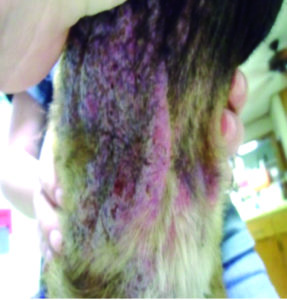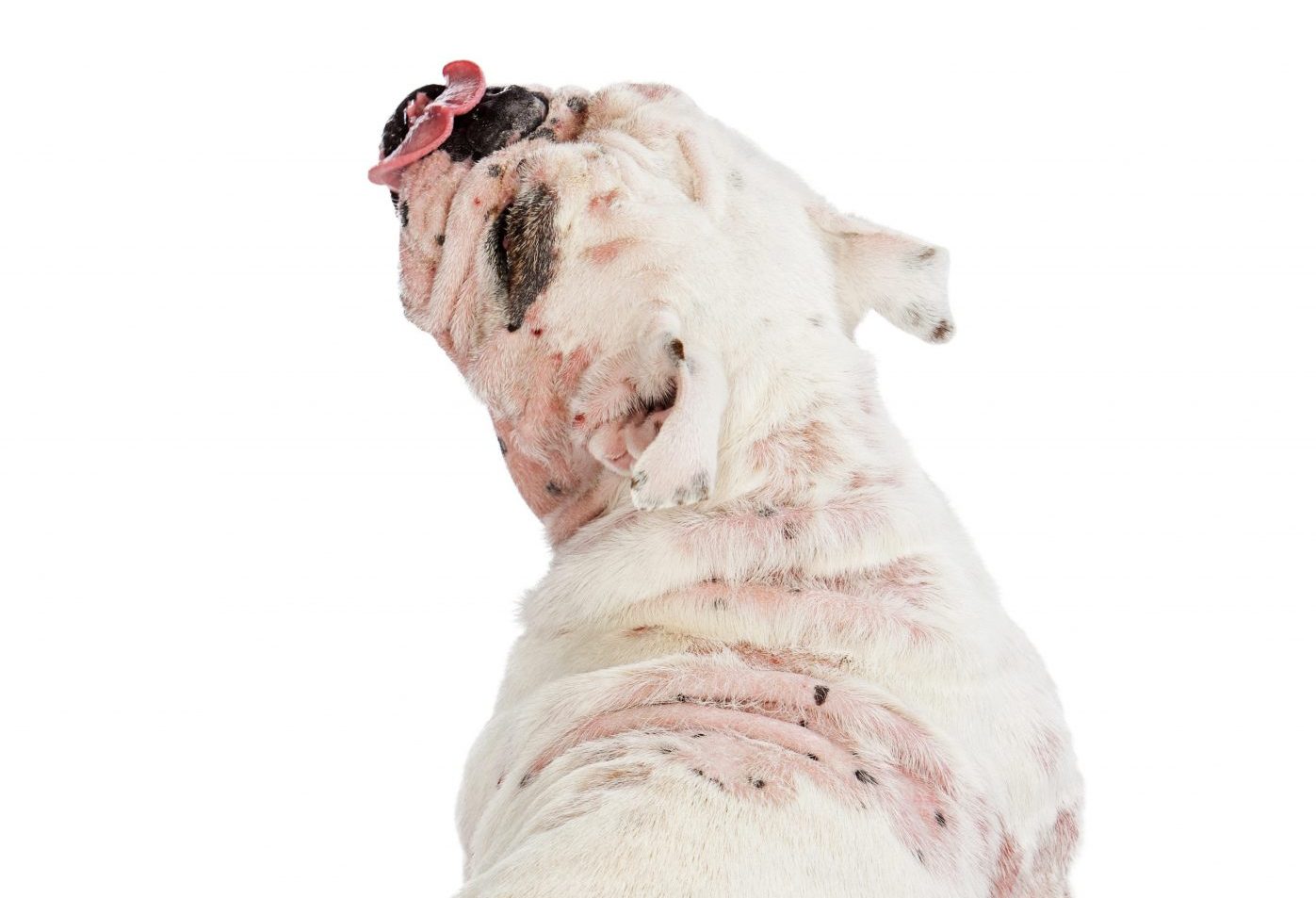Stubborn cases of demodectic and sarcoptic mange in dogs respond to a combination of conventional and complementary therapies.
Skin problems in dogs can be persistent and unsightly. They can also defy strictly conventional treatments. This can be especially true of parasitic invasions, of which the most common are Demodex and Sarcoptes – the species that cause mange.
Demodectic mange
Also known as demodicosis, colloquially called “red mange”, demodectic mange is caused by a microscopic mite of the Demodex genus. A normal inhabitant of canine skin, this mite’s 20- to 35-day life cycle from birth to death takes place on an animal host. Demodex mites are transferred through direct contact from the bitch to her puppies, during their first week of life. When there is disruption of natural balance, these mites can proliferate out of control, causing skin disease.
Symptoms include localized or diffuse alopecia, erythema, and comdones associated with papular and pustular dermatitis. It is often associated with folliculitis and furunculosis due to secondary opportunistic bacterial and/or mycotic infections, such as Malassezia, when there are changes in the cutaneous micro-environment and/or alterations of host defense mechanisms.
Factors implicated in the appearance of clinical signs of demodectic mange include genetic predisposition, malnutrition, immuno-suppressive conditions, such as stress in puppies and/or vaccination. It should be noted that heavy metal toxicity suppresses the immune system and opens the door to chronic conditions. The vaccine preservative thimerosal (a mercury additive) is immuno-suppressive and may be a contributing factor to the appearance of demodectic mange in post-weaning puppies, and perhaps older pets. In older dogs, neoplasia, steroid use, diabetes, hyperadrenocorticism and metabolic disease have been implicated.
Localized demodicosis, usually in juvenile dogs, occurs as isolated scaly bald patches, usually on the face but occasionally elsewhere. It is considered common and the majority of cases resolve with no treatment of any kind. Localized disease does not involve more than two body regions. (One or two spots on the face and a leg would still quality as localized even though the spots are not close together.) Localized disease involves no more than four spots on the dog.
Generalized demodicosis can be very difficult to treat, and requires persistent intervention and dedication, since it is multifactorial and often complicated by concurrent infections.
Demodectic pododermatitis is very resistant, confined to the paws, and often accompanied by bacterial infections, as the foot is the last stronghold of the mite. Old English sheepdogs and Shar peis tend to get severe forms of this condition.
Sarcoptic mange
This type of mange is caused by the deeply burrowing mite, Sarcoptes scabiei. It is extremely contagious between dogs, and can be transmitted to people. It is the mange most people picture when they think of a “mangy dog”. Dogs are highly pruritic, with progressive hair loss, reddened skin and scabbing, especially on ear flaps, eyes, elbows, feet and chest. It is often difficult to detect on skin scrapings, so it is often better to treat it on clinical signs, even in the presence of a negative scraping.
Complementary treatments
Physiological stress is an important factor in the severity of demodectic mange, so consider diet and nutrition, internal parasite control, judicious use of vaccines, and spaying females to minimize the hormonal shift that causes mites to proliferate. Avoid steroids, as they suppress the immune response. Both endogenous and exogenous steroids will cause significant involution of the thymus gland. Which brings us to our complementary therapies.
As always, be sure to work with a veterinarian who is experienced in using these treatments:
- Thymus extracts come from the thymus glands of bovine, ovine or porcine sources. Basic and clinical research has been conducted on these since the early 1900s. The results are encouraging and demonstrate the effectiveness of oral or injectable thymic fractions. Thymus extracts have been shown to modulate the production, maturation and activation of T lymphocytes and macrophages, and to stimulate conversion of immature thymocytes (T6 cells) to non-dedicated T cells (T3 cells) in human bone marrow. Auto-hemo therapy will help with modulating the immune system, and with reducing the antigen/antibody reaction to the self tissues, down-regulating chronic inflammation. This is one of our mainstays in the treatment of immunological challenges.
- Beneficial classic homeopathics include Sulfur, Silicea and Psorinum. It is best to consult a qualified homeopath and make sure the remedy fits the case.
- Also recommended would be an immune-stimulating glandular complex compound, and supplements that target gut/liver function. We routinely use blue-green algae as a bio-modulator, along with other supplements. A badly afflicted older dog with Demodex benefited from the algae compound in addition to his ivermectin and Preventic collar, despite having concurrent ehrlichiosis.
 Other adjunctive care includes:
Other adjunctive care includes:
- Vitamin E (natural), up to 1,600 IU/day in divided doses.
- Omega-3 fatty acids can reduce the baseline inflammation.
- Lemongrass and cedar oil have been reported as effective therapeutics, as an adjunct to immune support.
- Herbals and supplements to fight bacterial infections and strengthen the immune system include Echinacea, arabinogalactans, olive leaf, neem leaf, colostrum and pau d’arco.
- Also useful for infection is colloidal silver, which can be used topically or orally.
- Virgin coconut oil shampoo at high concentration (70% to 80%) eliminated Sarcoptes spp and Demodex spp. by about the tenth week of treatment.
- We have also been intrigued with the use of Manuka hydrosol formulas, which have antibacterial, anti-inflammatory, anti-yeast and reparative qualities.
- Neem oil is helpful for both demodectic and sarcopic mange. Bathe three times weekly with 1 oz to 2 oz of neem oil per 16 oz of shampoo.
Conventional medications
- Dipping – Paramite dip (a discontinued organophosphate) and lime-sulfur dips were mainstays of treatment for sarcoptes mange, but of very limited value in demodicosis. Generally, anything that will clear Demodex will control Sarcoptes.
- Goodwinol ointment – used for many decades in our practice, since approximately 10% of localized demodicosis cases will progress to generalized demodicosis, often with lymphadenopathy. Thus, we are in favor of improving the general health of the skin and immune system. Total resolution is usually less than three months.
- Ivermectin – a broad spectrum, inexpensive parasiticide. It must be used with caution in dogs with the MDR (Multi-Drug Resistance) gene, such as sight hounds and herding breeds. Ivermectin is injected or given orally, depending on toleration. We have had success giving ivermectin two to three times weekly, though the literature suggests daily dosing.
- Moxidectin (Advantage Multi®) – can be used to treat demodicosis and is often effective if used weekly.
- Doramectin – given as injections or orally every one to two weeks, or milbemycin (Interceptor) every two weeks.
- Milbemycin oxine (Interceptor) – can be an effective but expensive approach to generalized demodicosis. May be used in dogs with genetic sensitivity to ivermectin (herding breeds, primarily, carrying the MDR gene). Some dogs require concurrent dipping.
Case study – Annabell

Eight-month-old boxer Annabell was diagnosed with generalized demodetic mange. She was treated with oral ivermectin. Her immunological issues were approached with a thymus injection combined with Heel products Cutis comp and Coenzyme comp (no longer available in the US, but can be sourced from Europe). A supplement called Pentagenesis was sent home for general support and repair, and a Manuka-based topical spray was dispensed for the inflammatory lesions. Her diet was changed to a grain-free kibble.

The second picture shows Annabell one month later. The lesions improved significantly over her entire body and the foot lesions disappeared.
If you suspect your dog might have mange, take him to an integrative veterinarian for a checkup, proper diagnosis, and to formulate a treatment plan. A regime that pulls from both conventional and alternative therapies is the best approach for this stubborn skin disease.








